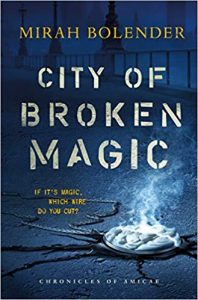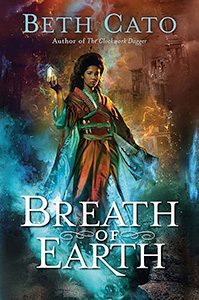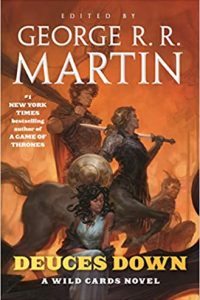Lila Garrott Reviews City of Broken Magic by Mirah Bolender
 City of Broken Magic, Mirah Bolender (Tor 978-1-250-16927-3, $15.99, 400 pp, tp.) November 2018. Cover by Tony Mauro.
City of Broken Magic, Mirah Bolender (Tor 978-1-250-16927-3, $15.99, 400 pp, tp.) November 2018. Cover by Tony Mauro.
Mirah Bolender’s debut is an enjoyable, anime-influenced romp, with a surprising amount of attention paid to the details of the worldbuilding, and more three-dimensional characters than the Stuff Blows Up genre usually receives.
In this case, the Stuff that Blows Up is magical: specifically, the people of this alternate-universe Japan use amulets to accomplish day-to-day tasks such as heating houses and jumping long distances. Amulets are hollow inside, filled with magic. When the magic runs out, the space can be taken over by shapeshifting monsters made of darkness, and those monsters eat people and anything else in their path in order to spread. Luckily, they shy away from and are eventually destroyed by strong light – and also by some weapons proprietary to the Sweepers, whose job it is to clean up monster infestations arising from broken or forgotten amulets.
Unfortunately, the city of Amicae has for generations maintained a propaganda campaign insisting that monsters cannot occur inside the city walls. It is a flagrant lie, but much of the population believes it, including some of those who allocate civic funding. Consequently, the Sweeper department of Amicae is down to two people, the irascible and overworked Clae Sinclair, whose family business it is, and his young, up-and-coming apprentice, Laura Kramer. The cultural norms of this steampunkish society tend toward the Victorian, and Laura faces substantial day-to-day misogyny in her attempts to carve out a career. For her, Sweeping is defiance, excitement, and the chance to be herself in the face of everyone’s judgments. To her family, it’s a bizarre (although high-paying) choice likely to push Laura out of respectable marriageability. And to Clae, Laura is a necessary and trusted annoyance, because infestations in the city are suddenly becoming more frequent.
The book is packed with monster-fighting action and cinematically detailed battle scenes, but the backstory we get on the larger world, the reasons the city of Amicae and others like it were founded by invaders from overseas, and the specifics of the ways magic works are just as interesting. There’s a story hidden under the surface of the book, about the indigenous tribes who were conquered by the invaders, and its outlines are clearly apparent despite Laura being sufficiently privileged that she never really has to think about it. That under-story is the part of the plot being set up for a future sequel. This is just as well, since, though the narrative never suggests that the invasion was a good idea or that the near-genocidal treatment of the indigenous tribes was in any way justified, it’s a little eyebrow-raising in this day and age to have the indigenous people be literally magical, with magical secrets the conquerors don’t know, and to have them be people who live in hiding and are, it is implied, slowly vanishing. These are tropes that get used a lot about indigenous people in pop culture generally, and it doesn’t help that the tribes speak Japanese and are heavily implied to be people of color, while the conquerors speak English with some Latin and are heavily implied to be white. In fact, the country is cut off from the rest of the world in a way clearly meant to bring to mind the years before the opening of Japan to the west, except that in this version, white people are running the place. Fortunately, the principal indigenous character we get, Okane, an addition to the Sweeper force, is three-dimensional, interesting, and has agency in the plot, so hopefully future installments will add nuance to what is currently a fairly generic look at imperialism.
This is, however, really the book’s only major flaw, if one is willing to overlook a small amount of infodump, justified in-story by Laura’s position as an apprentice being instructed. Overall, things like the logistics of the propaganda machine that keeps Amicae’s news in line are portrayed fascinatingly and in depth, even as the plot never stops ticking. The action scenes succeed at being different from one another, escalating at a reasonable rate, and establishing the rules of what can happen thoroughly enough for the final setpiece to be as apocalyptically over-the-top as anyone could possibly hope, and the aftermath isn’t brushed off or neglected, either. This is the kind of debut that begs for a screen adaptation, hopefully with a large animation budget, and its particular blend of suspense and shoot-’em-up with magic-system geekery and character growth is unusual and exciting to encounter.
This review and more like it in the November 2018 issue of Locus.
 While you are here, please take a moment to support Locus with a one-time or recurring donation. We rely on reader donations to keep the magazine and site going, and would like to keep the site paywall free, but WE NEED YOUR FINANCIAL SUPPORT to continue quality coverage of the science fiction and fantasy field.
While you are here, please take a moment to support Locus with a one-time or recurring donation. We rely on reader donations to keep the magazine and site going, and would like to keep the site paywall free, but WE NEED YOUR FINANCIAL SUPPORT to continue quality coverage of the science fiction and fantasy field.







